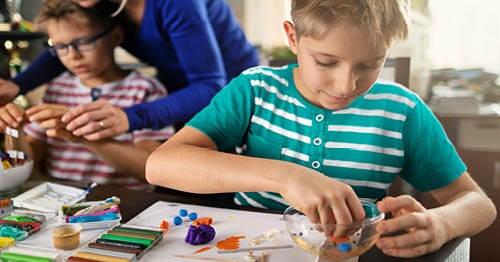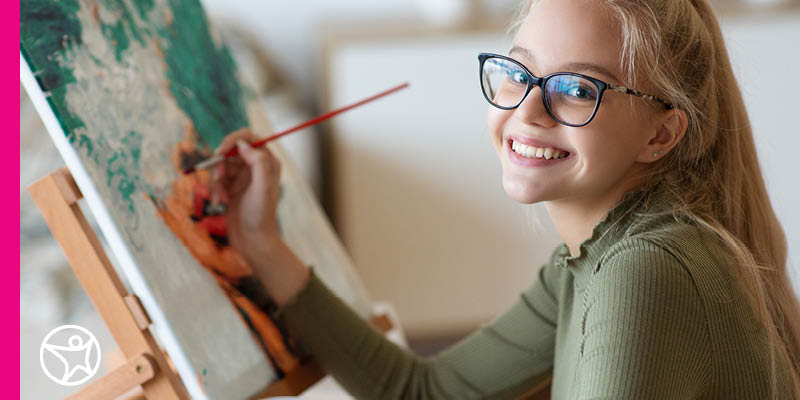Connections Academy vs. Other Online Schools
by Connections Academy
byConnections Academy
6 min to readDuring art class, students are encouraged to express themselves creatively. They’re given an avenue to channel their emotions into something that often leaves them feeling proud and like they’ve unlocked a new skill. This makes art class one of the more sought-after electives, as it gives students a chance to reflect and create in an environment that is safe and welcoming.
We all have fond memories of seeing our creations decorate the classroom walls as the scent of art supplies wafted in the air. The art room is a vital place for young artists to refine their skills and find their style, especially as they get older. But, what happens when you take traditional art instruction and put it in the virtual classroom?
When enrolling in a virtual school, parents might wonder whether their children will get the same opportunities as students who attend in person. Art class seems to be something a lot of caregivers worry their virtual student won’t get to experience to the fullest, which is simply not the case. In fact, virtual art instruction breaks down barriers that the in-person classroom can’t contend with.
Connections Academy® teacher April Morgan suggests that her time teaching art virtually, has been more of a success than her in-person experience, stating, "Honestly, I feel like the [curriculum] is more thorough and more challenging than what I've taught before, and kids are typically very successful with it."
While it may seem like it’s less cost-effective to provide art instruction virtually with families often having to purchase their own supplies, it actually allows for more flexibility in curriculum. Virtual art classes empower teachers and students to try out digital tools and software in addition to traditional artistic mediums. So while students may be painting on canvas one day, they could be getting a crash course in digital art tools the next.
April tells us that the way she approaches virtual art instruction is wide-ranging. “[My class] is a little bit of everything. We do the elements and principles of art." She says her class is less focused on art history and more on “getting [students] to view art and view the world in a way they maybe haven’t before.”
Like their in-person counterpart, online art courses also foster creativity and promote self-confidence. Students learn to be proud of their accomplishments and watch their art skills progress over time. This self-esteem boost can have a profound effect on their overall educational performance. Many students look forward to their art courses as a break from the heavy workload of their other classes, as well as a chance to express themselves in a healthy way.
April tells us that “there’s a lot of research that says when kids are successful in art, across the board they tend to be more successful in academic areas.” She suggests that art “really turns on the part of your brain dealing with creative problem solving and drawing inferences between two things you might not have seen a relationship between before."
The skills that students frequently use in art class often can then be translated to their other courses for higher success. Art courses provide a chance for holistic growth and by providing virtual art classes to students, you’re giving them a chance to destress from their courses while learning how to express themselves creatively with skills learned in class.
April also suggests, “I feel like [art is] one of those subjects where everyone thinks that you're either like born with something where you can magically create beautiful art, but really it's just practice." Kids often believe that skills are something you either have, or you don’t, rather than practice being necessary. "They say that it takes 10,000 hours to become an expert at something, but the more you practice, the better you get, and the more confidence you have”.
Not to mention, art education serves as a means of communication for many students who have difficulty expressing themselves otherwise. Middle and high school students are all going through a great transitional period and they can convey complex emotions and ideas through a visual medium. Art education also fosters an appreciation for different ideas, cultures, and diversity that your child can carry with them forever.

Art education doesn’t have to be confined to the classroom, either. If your child is interested in artistic pursuits, you can nurture their creative development outside of class in a few different ways.
Giving your child a space in ytheir learning environment to foster their creativity will help them feel encouraged to create. You can either make space in their own room, or dedicate another room in the home to their pursuits. Having a place where they can immerse themselves in their art with physical or digital art supplies will give them the freedom to experiment and express themselves without restraint.
Visiting museums, local art exhibitions, or even workshops and events focused on art, will give your child a new perspective on their own creativity. It will give them a chance to explore different mediums and styles and broaden their artistic horizons comfortably. Look for different events or classes in your community or online that align with their specific creative interests and allow them to participate.
April believes that taking your children to artistic outings in your local area is a great idea and that some kids “might really benefit from a self-guided or tour-guided exploration of a museum." She also notes that “there are so many resources online, and kids are very good at finding them,” so if your kids are looking for more to do with art, parents should “take the lead on figuring out ways to foster more of an interest in growth.” She says all of these things, combined, will help “broaden their their view of arts and help them figure out more who they are and who their interests are or what their interests are."
If your child is only learning specific mediums in their virtual classroom but they want to explore different ones, offer them the opportunity. Take a trip to your local art supply store, or download virtual tools they can play with on their computer. Conduct research with them into these different styles and create a dialogue so they can feel comfortable expressing their ideas, inspirations, and challenges freely.
April encourages parents to look to their children for guidance on how to foster their creative expression. “I would suggest that parents really think and ask what their kids are interested in and start there, because if they're working on something they're interested in, they're probably [going to] have more focus.” This way, parents allot time and resources to what their children will feasibly work on, rather than investing in a bunch of different mediums. She also suggests that they ask their children “what [they’re] interested in outside of art” as a way to encourage them to “bring it to their art,” to be more excited about what they’re working on.
Parents are powerful advocates when it comes to nurturing creative expression, so by allowing them to explore their artistic talents you are helping them to grow. Our Connections Academy community is full of resources as well to help you foster their curiosity and instill them with a lifelong appreciation for the arts.
by Connections Academy
by Valerie Kirk
by Valerie Kirk
